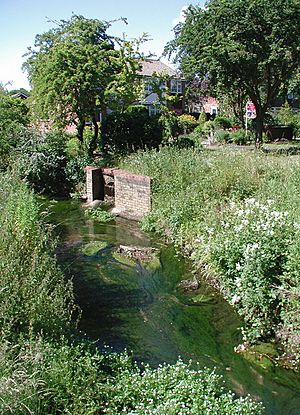Welbeck Hill facts for kids
Welbeck Hill is a cool historical spot in North East Lincolnshire, England. It's about 1.75 miles from Laceby and 3 miles from Riby. Here, archaeologists have found ancient Roman pottery and an Anglo-Saxon cemetery. These finds tell us a lot about people who lived here long ago.
Contents
Exploring Welbeck Hill's Past
People have been interested in Welbeck Hill for a long time. In the 1800s, a man named George Oliver visited the area. He thought the hill might have been an ancient fort. He saw old earth walls and a ditch around the hill. These could have been defenses for a watchtower. This watchtower might have protected a Roman camp nearby.
The Mystery of Welbeck Spring
Oliver also wrote about a special spring near Welbeck Hill. This spring, called Welbeck spring, had a strange secret. It would be completely dry all winter. But in February or March, a loud rumbling sound would come from the ground. Then, water would burst out in many places. In just a few hours, the whole area would fill with water!
This spring, along with others, feeds into the Laceby Beck. The Laceby Beck then flows into the River Freshney. Finally, it reaches the sea near Grimsby. The Laceby Beck is a very rare type of stream. It's a chalk stream fed by springs. Because it sometimes has low water levels in summer, people are working to protect it. A special conservation program started in 2013 to help keep it healthy.
Ancient Pottery Discoveries
Archaeologists have found many interesting things at Welbeck Hill. On the southern side of the hill, they found pieces of Roman pottery. These included parts of a grey dish and a cooking pot. They also found strong, well-made pottery shards.
Near the cemetery, they discovered Anglo-Saxon pottery fragments. These were similar to other Anglo-Saxon pottery found nearby. There was also an area of dark soil. This soil contained many animal bones, showing where people might have cooked or eaten.
Uncovering the Anglo-Saxon Cemetery
The Anglo-Saxon cemetery at Welbeck Hill was found by accident. In 1962, a farmer's plough disturbed some remains. This led G. Taylor to start digging and exploring the site.
Burial Areas and Graves
So far, three main burial areas have been found. They date back to the mid-5th and 6th centuries.
- One area runs north to south along the top of the hill.
- Another area is on the western slope, running east to west.
- A third area on the eastern slope holds cremated remains.
From 1962 to 1976, archaeologists recorded 76 graves and 5 cremations. In one unusual grave, a woman's body was found without her head. It was placed on top of an older, important man's body.
Treasures from the Graves
The cemetery was used until the late 6th or early 7th centuries. During this early Anglo-Saxon period, it was common to bury people with their belongings. This is why many graves at Welbeck Hill had cool artifacts. The items were well-preserved and showed what life was like back then.
Some of the amazing things found include:
- Iron knives
- Cruciform brooches (decorative pins)
- Beads
- A cooking pot
Many items had spiral designs, like "serpent rings" and a round brooch. Even tiny pieces of fabric were found. These textile remains show that the Anglo-Saxons at Welbeck Hill were skilled weavers. Their sewing techniques, like disguising seams with braids, were similar to those found at the famous Sutton Hoo site in Suffolk.
A Mysterious Silver Charm
In one woman's grave, archaeologists found a silver bracteate. A bracteate is a thin, round metal charm. This one had a runic inscription that looked like "law." However, it might have been a mistake and meant "lap," short for "lapu." The word "lapu" was a magical word often found on these charms. It means "invitation" or "summons." It might have been an offering or a sign of joining a special group.
Other items found in this woman's grave included:
- Bronze objects
- Glass and amber beads
- An iron knife
- An iron buckle
- An iron ring
- Four iron keys
- An ivory ring
These finds help us understand the beliefs and daily lives of the Anglo-Saxons who lived at Welbeck Hill.


